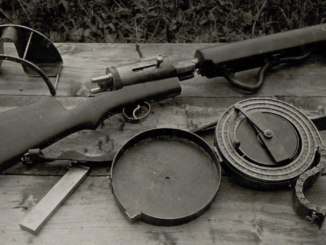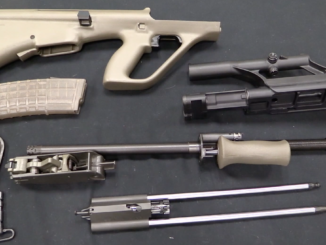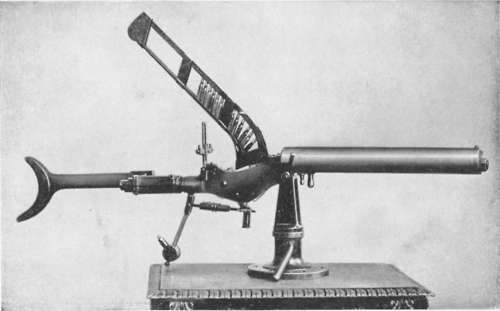One interesting specialized version of the Steyr MPi-81 is this model, built for the Steyr/Saurer 4K 7FA armored personnel carrier. The vehicle could carry 8 infantrymen and their compartment had four firing ports fitted with MPi-81 SMGs. The changes required from the standard MPi-81 pattern were:
– A longer barrel to fit into the gun port
– An optical sight very much like that of the Steyr AUG
– Removal the front sling swivel
– Addition of a mounting bracket for a brass catching bag
These are very rare guns to find these days, and I’d like to thank Joschi Schuy for giving me access to his to film! Additional thanks to the Heeresgeschichtliches (Military History) Museum in Vienna for the photo of the IFV.




I gotta be honest with y’all: I’ve always held the idea of a “firing port weapon” in contempt, going back to the earliest days of my military career when we were serving as training dummies for one of the very first Bradley units they stood up.
We had a platoon of them attack our position, complete with firing port weapons that were all “MILES’d up” with the training systems. The experience was pretty intense, but all that stemmed from having armored vehicles overrun the position. None of the assessed casualties we took that morning were from the firing port weapons, because they couldn’t hit a thing. It was so bad that the rigged-up MILES devices they had on them weren’t ever used again, and because so many of those fell off or got broken that they gave up on the entire idea of using them. The Bradley crews speculated that that was because having MILES on those weapons demonstrated how utterly useless those things were in the first place.
You can hit things with a firing port weapon. If the vehicle is stationary, and you can see something through your vision system. If the vehicle is moving, however, and you’re being thrown around inside as it moves…? Fuhhgeddaboudit. Anything you hit is only going to be by sheer statistically improbable accident.
Now, what works? A Remote Weapons Station with good optical controls. Bolt a couple of those onto the back of your Bradley, and you’ve got something worth having. The Germans put something similar on the Marder, but I’ve heard different opinions on its utility, but given that it had to be based on 1960s technology, I could see that.
Firing port weapons are essentially useless, and extremely dangerous to your own dismounted infantry. There have been documented cases of friendly fire taking out dismounts from other vehicles due to “issues”, and I think there are good reasons nobody uses those damn things in real life–They’re impractical and not all that effective. If you have to deal with close-in infantry, you’re better off going with having one of your partner vehicles spray you down with MG fire, or having a few “Claymore in a Box” affairs affixed to your flanks. The non-lethal Claymore mines we used on the tracks that were set up to go into the camps in case of riot in Iraq were a good example of this.
We set up live-fire ranges a couple of times for the Bradleys to use. The notable thing was how few silhouettes were ever hit by the FPWs. I think they were even scored on it, for their Table VIII, right up until they realized nobody was getting any hits on that part of the range. Ever.
This old tanker says, “Amen, Amen and Amen, brother”. The idea was based on German WW2 experience where the panzergrenadiers would roll up on top of Russian positions in their halftracks, stay mounted and blaze away. So, when the Bundeswehr was founded they adopted the Schützenpanzer Lang HS.30, formally Schützenpanzer, lang, Typ 12-3, or SPz lg 12-3 for short “Rejecting American doctrine that an armored personnel carrier should serve as a “battlefield taxi” and not as an assault vehicle, the Germans developed the HS.30 as a vehicle to fight alongside tanks and from which their mechanized infantry could fight from under cover. The German military came to this decision as a result of its World War II experience with Panzergrenadiere (armored infantry).” This turned out not to be a success, so they began work on the Marder Infantry Fighting Vehicle. Hearing about this, the US Infantry School began toying with the idea on a low priority, calling it the MICV https://en.wikipedia.org/wiki/MICV-65#:~:text=MICV-65%2C%20short%20for%20Mechanized%20Infantry%20Combat%20Vehicle%2C%201965%2C,them%20entered%20service%20for%20a%20variety%20of%20reasons. But what really set the cat on fire is when the Russians (having learned of German developments from spies) actually fielded the theorists dream vehicle – the BMP. It had it all, a turret mounted 73mm gun with 7.62mm coax, a Sagger AT missile mounted above the gun, firing ports for the dismounts in the side and rear. The result was panic in the Pentagon. Overnight, it went from toying to “we need this by YESTERDAY!” (” Military theorists turned to the concept when the Soviets were the first to follow the adaptation to this new style of combat, issuing requirements and then introducing the BMP in the late 1960s, followed soon after by the second German IFV Marder.”) Then reality mugged theory. Some Arab units had been equipped with BMP’s and tried using the Russian’s Infantry Fighting Vehicle tactics by attempting to overrun Israeli units in the Yom Kippur War. Unfortunately, the Israelis of 1973 were not the Russians of three decades earlier – they massacred the BMP’s. The firing point weapons proved useless. (I learned this, to my surprise, from Israeli classmates at the Armor Officer Advanced Course in 1979). This information was obviously provided to the US authorities but a combination if two factors prevailed 1) “We’re the Americans, not the Arabs, our well trained troops will be able to use their firing point weapons effectively” 2) The IFV had become such a juggernaut that it was impossible to stop. Initial versions of the M2 retained the firing ports, but they were plated over with additional armor in the A2 and A3
for “point”, I meant “port”
The port hardware sounds more interesting than the gun. I wonder if anyone has collected samples?
Some ideas seems to return periodically like tank sub-machine guns, for earlier execution of this idea see Steyr-Solothurn S17-100 https://guns.fandom.com/wiki/Steyr-Solothurn_S17-100
“I think they were even scored on it, for their Table VIII,” Table VIII is the Tank Crew Qualification Course, where a crew is certified as combat ready by successfully engaging targets while moving down a live fire range. It is the culmination of training and range firing beginning with Table I. Higher levels include Tables IX to XII, Platoon Live Fire. Table XIV is the Two Way Range conducted a certain overseas locations
Some last comments 1) From talking to infantry colleagues, they intended use nothing but tracers in the FPW’s in hope the firer could “walk: his rounds onto the target 2) One of the big problems with designing the firing ports was to make sure they sealed and stayed sealed against Chemical Agents and Fallout 3) “Elastic Strap” Ian, to millions of old US soldiers (and I presume vets of the other services) that is known as a “Bungee Cord” – a highly useful piece of gear. Here’s a picture of an early door gunner in Vietnam, before they had developed a mount for his gun [img]https://i.imgur.com/eMGAusV.jpg[/img]
If that didn’t come through, try this https://imgur.com/eMGAusV
I had no idea that Buddy Holly served in the Nam.
What, you’ve never heard of the Singing Door Gunner
The stupid idea behind firing ports was that an unarmed but armored transport could not defend itself if swarmed by enemy infantry with sticky bombs or magnetic anti-armor grenades. Obviously, only an idiot would let a battle taxi get swarmed like that in the first place. I could be wrong.
Cherndog, No the Germans were influenced by their WW2 experience against the Russian (I’m not aware of the trick being tried against the Western Allies). Of course, the mid and high leadership of the Bundeswehr were WW2 veterans to the man, so the wanted an assault vehicle for their infantry. In retrospect, a flawed idea, but combat experience is not thrown away lightly. In the HS30, a hatch opened over the infantry compartment and they just exposed their upper body to fire. But they were still partially exposed to airbursts, chemical weapons and fallout. Solution, put a roof over their head and give them firing ports. Suppress the enemy via “spray and pray”. So, it was logical, but it ignored practicality – whether manually controlled fire from a rolling, bouncing, pitching, yawing vehicle, coupled with lousy visibility meant anything worthwhile was achieved. Maybe it could be – so much lead would be flying around that somebody might get hurt. For not the first time (and not just in the military), a beautiful theory met brutal reality. In retrospect, the original idea was flawed, so developments from it, no matter how logical would also be flawed. And don’t even get me talking about the BMP’s little brother – and I mean little. An air droppable tin can with half a dozen desantniki on top of one another.
The Russians “responded” to HS30 with the “8 rad” BRDM, which also had that top hatch arrangement.
Quite aside from the fact that infantry still mounted is another way of saying infantry “bunched”, our infantry called the BRDM the “Boredom” because it was extremely easy to kill. 7.62 NATO from 200-300 meters into the right or left front wheel would not only take out the tire, but also punch through the thin plating behind it and either kill the driver (left front) or set off the front fuel tank (right front). .50 MG could do it from 800 meters.
As for the whole genesis of fire ports, U.S. Army Ordnance has to bear some blame, although the real stupidity was mainly British.
Going back to WW1, British “rhomboidal” tanks had firing ports on their sponsons with LMGs in them; the “Whippet” in fact had four Hotchkiss LMGs in ports in its fixed casemate and nothing else. In the 1919-22 War of Independence in Ireland, Whippets were used in Dublin and other cities by literally parking them in street intersections so they could fire down four streets simultaneously.
British tanks also had larger ports with no mounted MGs, that some people who should have known better decided were “pistol ports”. They were actually for letting loose carrier pigeons (!);
https://www.military-history.org/wp-content/uploads/2018/01/Pigeons-in-Tanks-Corps-service.jpg
The confusion carried over in tank turret design in early WW2. The Canadian Ram and its progeny, the Sherman, both had “pistol ports” on the left rear quarter of the turret. In fact, these rather large “ports” were useful for loading live ammunition at dumps and disposing of empty shell casings as needed. The “pistol port” was left off the M4A3 turret at first, but was restored later in production due to requests from the “end users”. The feature carried over to both the M26 and M46 tanks.
The Centurion I-III also had such a “pistol port”, always just big enough to get a `17-pounder or later 20-pounder or 105mm round through. Where it was at, between two external equipment boxes, it would have been bloody useless as a firing port, but by then everybody knew what it was really for, never mind what they called it in the manual. Even the Chieftain had such a port, for loading rounds.
In an amusing sidelight, the Russian BT series tanks had actual, honest-to-Lenin pistol ports in each side of the turret, about 2cm in diameter. And their crews were issued Nagant revolvers for FPWs because the ports were too small to admit the front end of the Tokarev self-loader. At least two prototype auto pistols were designed with barrels slim enough to be used that way, but the beginning of WW2 ended their development.
The pistol port, like the FPW, is an example of a seemingly great idea that didn’t work out. But it still belongs on a tank turret because you have to load and unload the main gun rounds somehow.
cheers
eon
“(…)At least two prototype auto pistols were designed with barrels slim enough to be used that way, but the beginning of WW2 ended their development.(…)”
No, according to https://ru.wikipedia.org/wiki/%D0%9F%D0%B8%D1%81%D1%82%D0%BE%D0%BB%D0%B5%D1%82_%D1%81%D0%B8%D1%81%D1%82%D0%B5%D0%BC%D1%8B_%D0%92%D0%BE%D0%B5%D0%B2%D0%BE%D0%B4%D0%B8%D0%BD%D0%B0_(1939) number of produced was between 500 and 1500 examples, example is shown dated 1942 implying it was made as late as 1942.
“(…) “8 rad” BRDM(…)”
What is this?
I think he mixed up the BRDM reconaissance vehicle (four wheels) with the eight-wheeled BTR series of vehicles. “8 Rad” being German for 8 wheel.
Little Brother was the BMD. Sorry, I;mnot fully awake yet
For visual illustration incl. firing ports of popular Cold War era Soviet vehicles see https://comicbookplus.com/?dlid=26458
I think the entire IFV concept is fundamentally flawed.
I’ve spent a bunch of time supporting Bradleys and tanks; I’ve been an Observer/Controller at the National Training Center; I’ve also been there in the CP in Iraq while mech infantry were doing their thing.
Never once did I see a situation where it made sense to have the dismount infantry and the firepower of the turret on the Bradley be in the same place at the same time. For the mech infantry commander, it’s a choice between two lousy options: Either you keep your tracks where they can range and get good fire solutions on the objective, making your dismounts cover the terrain in between the two on foot, exposed to all and sundry, or you use your firepower assets as taxis, risking their loss to direct fire, and get the infantry to where they need to be dropped off.
You only get bad choices with the IFV. If, on the other hand, you separate the firepower from the people-mover? Life makes a lot more sense, and you don’t have to worry about the intrinsic stupidity of taking a bunch of guys out into the armor battle as mostly ballast in lightly-armored vehicles. Which are lightly armored because you have to haul the troops in them, in the first place…
If it were me, there’d be tanks, fire support vehicles that looked a lot like the Russian BMPT, and armored personnel carriers that didn’t have much in the way of armament, in order to discourage their use by budding Rommels or Pattons as actual armored fighting vehicles. Which, manifestly, they are not…
Uh, yeah, the armored personnel carriers are NOT supposed to take on tanks. At best, they’d be given heavy machine guns for fending off ambushes by enemy infantry, with orders to get the hell out of the ambush zone ASAP (dismounting your infantry in the middle of an ambush is going to get the majority of them reduced to hamburger). Get the infantry carrying capacity the heck out of your Bradley vehicles and optimize the Bradley platform as an armed scout with tank-killing capabilities. No need to have dead riflemen in the vehicles while you’re attempting to deflect enemy fire. I could be wrong.